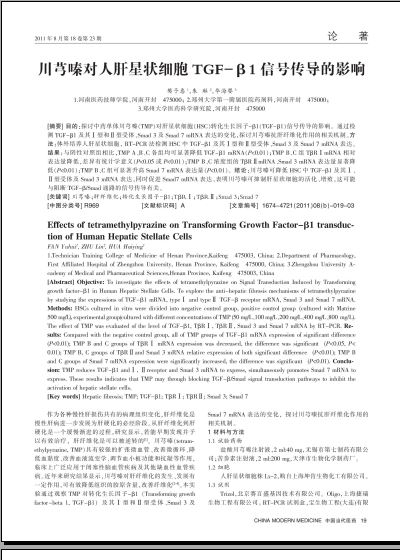川芎嗪对人肝星状细胞TGF-β1信号传导的影响(3)
 |
| 第1页 |
参见附件(3068KB,3页)。
近年来中药通过对TGF-β/Smad信号通路的干预,防治肝纤维化日趋受到重视。川芎嗪可抑制肝纤维化大鼠的肝细胞凋亡,使肝组织TGF-β1显色指数降低,提示在川芎嗪的保肝作用中有阻断肝细胞凋亡的机制参与, 这可能与其抑制肝星状细胞(HSC)的激活, 减少TGF-β1的分泌有关[18]。但仍未见川芎嗪对TGF-β/Smad信号通路影响方面的详细报道。
本课题应用RT-PCR法,检测TMP对人肝星状细胞(Lx-2)中TGF-β1、TβRⅠ、TβRⅡ、Smad 3、Smad 7mRNA表达的影响。结果显示,经TMP处理的TMP 50 mg/L~800 mg/L浓度均可显著降低TGF-β1 mRNA(P<0.01);TMP 200 mg/L、800 mg/L组TβRⅠmRNA相对表达量降低,其差异有统计学意义(P<0.05或P<0.01);TMP 200 mg/L、TMP 800 mg/L浓度组的TβRⅡmRNA 、Smad 3 mRNA表达量显著降低(P<0.01);TMP 200 mg/L、800 mg/L组可显著升高Smad 7 mRNA表达量(P<0.01)。提示TMP可通过影响TGF-β1 及其信号通路发挥抗肝纤维化作用。
[参考文献]
[1]Friedman SL. Molecular mechanisms of hepatic fibrosis and principles of therapy[J]. J Gastroenterol,1997,32:424-430.
[2]董培红,朱碧红,郑宇,等.川芎嗪对内毒素刺激大鼠肝星状细胞增殖及瘦素和胶原表达的影响[J].胃肠病学和肝病学杂志,2005,6(14):605-608.
[3]梁英,李孝生,万晓强.川芎嗪和大磺酸对肝细胞增殖和凋亡的影响[J].中华肝脏病杂志,2006,14(3):219-221.
[4]谈博,宋健平,张奉学,等.川芎嗪对HSC-T6细胞Smad蛋白细胞内转位的影响[J].中药新药与临床药理,2006,17(5):320-322.
[5]Cressner AM. Transdifferentiation of hepatic stellate cells(Ito cells) to myofibroblasts: a key event in hepatic fibrogenesis[J].Kidney Int Suppl, 1996, 49(54):S39-45.
[6]Friedman SL. Molecular regulation of hepatic fibrosis, an integrated cellular response to tissue injury[J].J Biol Chem, 2000,275(4):2247-2250.
[7]Li D, Friedman SL. Liver fibrogenesis and the role of hepatic stellate cells: new insights and prospects for therapy[J]. J Gastroenterol Hepatol, 1999,14(7):618-633.
[8]Mann DA, Smart DE. Transcriptional regulation of hepatic stellate cell activation[J]. Gut,2002,50(6):891-896.
[9]Son G, Iimuro Y, Seki E,et al. Selective inactivation of NF-kappaB in the liver using NF-kappaB decoy suppresses CCl4-induced liver injury and fibrosis[J].Am J Physiol Gastrointest Liver Physiol, 2007,293(3):G631-639.
[10]Nagashio Y, Ueno H, Imamura M, et al ......
您现在查看是摘要介绍页,详见PDF附件(3068KB,3页)。